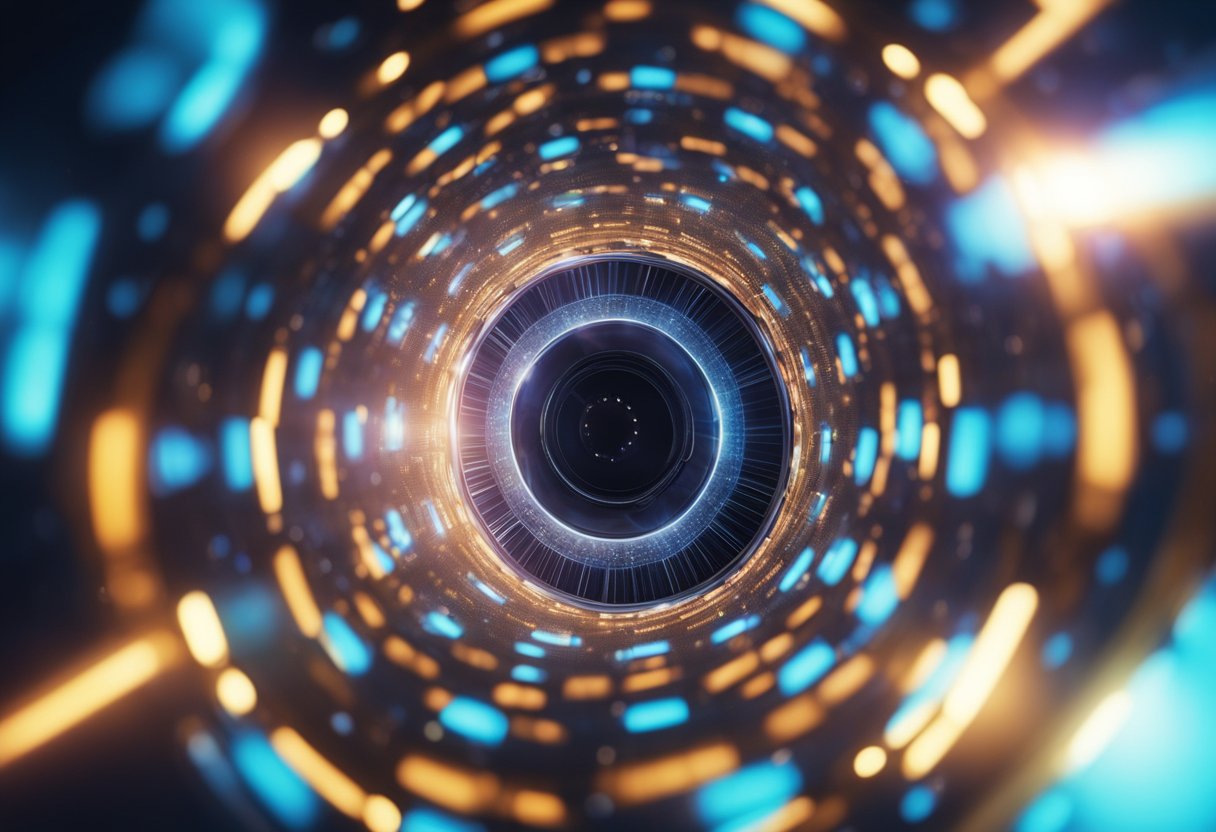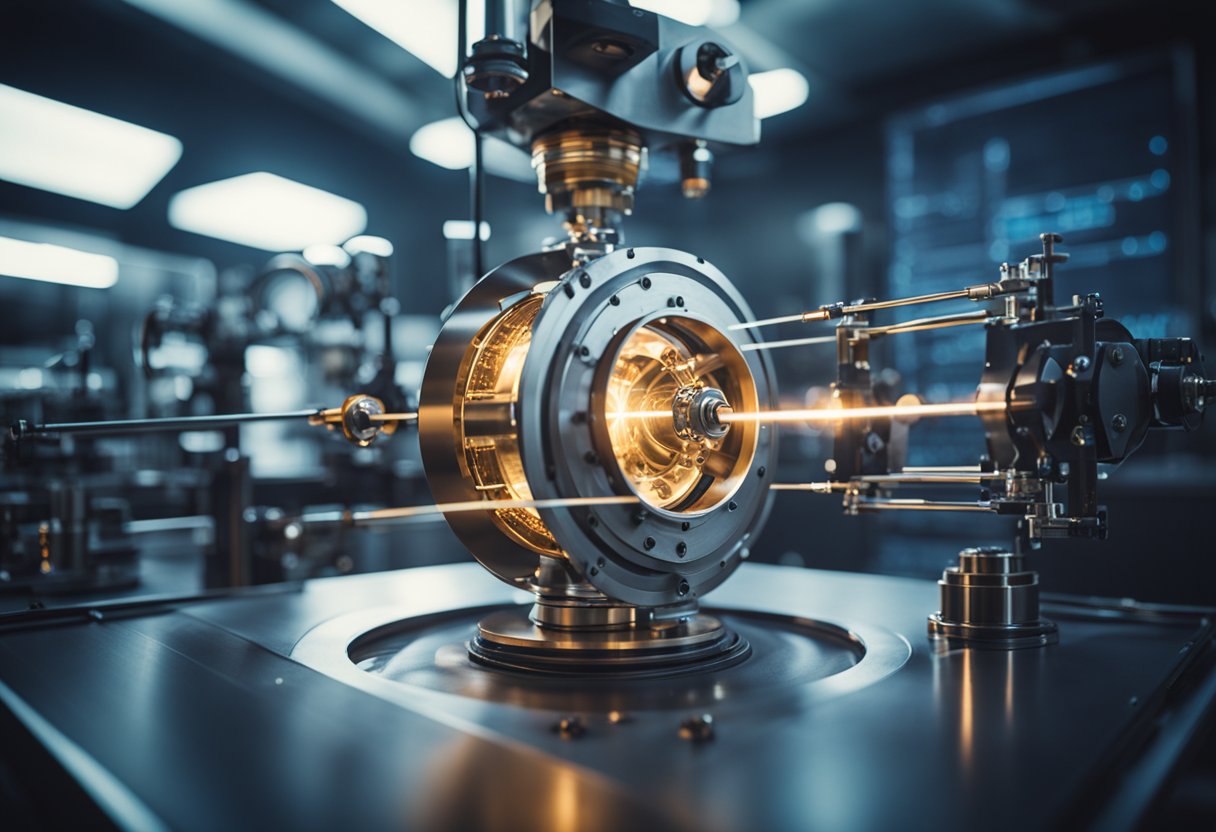
Quantum propulsion hypotheses represent a pioneering frontier in the realm of space travel. These advanced theoretical models explore the potential of manipulating quantum fields to achieve propulsion without the reliance on traditional reaction mass. This innovative approach could revolutionise our capability to traverse vast distances in space, significantly reducing the time required for interstellar travel. By harnessing phenomena such as the quantum vacuum or leveraging the principles of quantised inertia, scientists are challenging the conventional Newtonian framework and pushing the boundaries of what’s possible in propulsion technology.

Exploring the intricacies of quantum propulsion requires a deep understanding of both quantum physics and engineering. Theories propose various mechanisms by which a spacecraft could exploit the subtle forces and peculiarities of quantum mechanics to generate thrust. From the concept of a quantum drive that may defy Newton’s laws to the potential of using energy from the quantum vacuum itself, the diverse range of approaches reflects the innovative spirit of this scientific pursuit. Development of such systems also necessitates advanced materials designed to interact with quantum fields, as well as robust energy sources and storage solutions to sustain long-duration missions.
In decoding the fundamentals of quantum propulsion, we delve into the intersection of quantum mechanics and general relativity to explore their applications in propulsion systems. This understanding is crucial as it breaks conventional boundaries and defines new frontiers in space exploration.
Quantum mechanics provides us with a comprehensive framework that describes the peculiar behaviour of particles at the atomic and subatomic levels. Key principles like wave-particle duality help us comprehend that particles can behave both as solid matter and as probabilistic waves. This uncertainty and the concept of quantum entanglement could offer potential pathways to propel spacecrafts without the traditional expulsion of mass.
In terms of propulsion, we address how the quantum vacuum, which isn’t an empty space but a field of potential energy and virtual particles, can influence propulsive momentum. Propulsion hypotheses suggest that if we could manipulate these quantum fields effectively, we might be able to create thrust in the vacuum of space.
General relativity, Einstein’s theory which extends the laws of Newtonian physics to encompass gravitational forces as curvature in spacetime, also finds its place in the pursuit of quantum propulsion. The union of quantum mechanics and general relativity gives us a broader understanding of how mass, energy, and the very fabric of spacetime can be navigated to propel vessels across vast cosmological distances.
By analysing how matter warps spacetime, we may be able to develop a technological framework that harnesses these distortions to enable movement, thereby minimising reliance on conventional fuel sources. It is this revolutionary comprehension that might one day permit us to extend our reach to the far corners of our universe – an aspiration also shared by ventures such as SpaceVoyageVentures.com, which documents our journeys into the cosmos.
In our examination of advanced spaceflight, we focus on the utilisation of theoretical and experimental propulsion systems. These systems aim to revolutionise our approach to space travel by harnessing the principles of quantum mechanics and the behaviour of matter in a vacuum.
Matter-antimatter propulsion is a theoretical system that could become the pinnacle of rocket technology. By annihilating matter with antimatter, an immense amount of energy in the form of gamma rays and high-energy particles can be released. Proper harnessing of this energy could provide a highly efficient and powerful means of propulsion. It is a field marked by challenges, chiefly the production and containment of antimatter, but the potential rewards for long-distance space travel are unparalleled.
Quantum Vacuum Plasma Thrusters (QVPTs) represent a revolutionary concept in the realm of propulsion. They attempt to utilise the quantum vacuum, an environment where particles constantly flicker in and out of existence. This theory suggests that QVPTs could potentially extract momentum from the vacuum by utilising these temporary particles for propulsion. The controversial aspect of QVPTs lies in their reliance on principles that challenge conventional understandings of physics. Although experimental, like the IVO Quantum Drive, if realised, these thrusters could alter our entire approach to space propulsion.

In this section, we explore the pivotal roles that quantum fields play in emerging quantum propulsion theories, focusing particularly on how manipulation of these fields and the nature of quantum vacuum fluctuations could revolutionise our approach to space travel.
Theoretical proposals suggest that by manipulating quantum fields, we could potentially control the properties of space-time to produce thrust. This concept relies heavily on our understanding of quantum field theory as the mathematical framework that combines classical field theory, special relativity, and quantum mechanics. Recent hypotheses, like those proposed by researchers at the Soreq Nuclear Research Center, posit innovative methods to modify the momentum of the quantum vacuum that could be exploited for propulsion purposes.
Quantum vacuum fluctuations are temporary changes in the amount of energy in a point in space, as predicted by quantum field theory. They imply that the quantum vacuum is not a simple void but instead a complex and dynamic field. The idea is that these fluctuations could be harnessed to create propulsion mechanisms, which has become an intriguing area of exploration. For instance, could the Casimir effect—a phenomenon where two close conductive plates experience an attractive force due to vacuum fluctuations—be leveraged for propulsion? Understanding these fluctuations is crucial for advancing our knowledge and technology into functional quantum propulsion systems.
In crafting the next generation of propulsion systems, we focus on breakthroughs that combine cutting-edge physics with practical engineering to achieve efficient space travel. Our designs encapsulate the theoretical promise and the rigour necessary for operation in the harsh environment of space.
Magnetoelectric quantum wheels represent an inventive leap in propulsion technology, utilising the principles of quantum mechanics. At the heart of the quantum wheel is the delicate interplay between magnetic and electric fields, which generates propulsion without the need for traditional fuel. Our detailed designs outline:
The incorporation of magnetoelectric components offers a fuel-less mode of propulsion, harnessing the potential of quantum phenomena. This is particularly intriguing because it may offer significant efficiencies over conventional rocket propulsion, as mentioned in an arXiv paper on advances in engine efficiency.
Engineering for the vacuum of space requires an emphasis on reliability, redundancy, and resilience. Our engineering protocols include:
We’re mindful that the components must be engineered to precision, considering the absence of opportunities for repair once deployed. The rigour of our design process is reflective of our commitment to safety and functionality, elements that are essential for success in space travel, and informative for platforms like SpaceVoyageVentures.com that capture the imagination of prospective space tourists.

In the course of developing quantum propulsion systems, advanced materials play a crucial role, particularly due to their interactions with the quantum vacuum. Specific nanoparticles are being engineered to facilitate propulsion methods that, until recently, have been purely theoretical.
We understand that nanoparticles offer a range of unique properties that make them ideal for experimental propulsion methods. Due to their diminutive size, they can exhibit quantum mechanical properties that differ significantly from their bulk material counterparts. This includes altered electrical, thermal, and optical characteristics which are vital in capturing and utilising quantum effects for propulsion.
In the realm of quantum propulsion, nanoparticles are utilised to create differential forces in the quantum vacuum. This could theoretically provide a thrust without the need for traditional reaction mass.
Magnetoelectric nanoparticles are particularly noteworthy; they can couple magnetic and electric properties, which could be pivotal in interacting with the quantum vacuum. Research indicates that these materials have the potential to generate Lorentz forces when subject to electromagnetic fluctuation in the vacuum.
These forces usually cancel each other out, but with the correct geometric arrangement and material composition of magnetoelectric nanoparticles, it might be possible to create a net force. This could lead to methods of propulsion based on quantum mechanical principles that do not rely on expulsion of mass, unlike conventional rockets.
By investigating these advanced materials further, we are paving the way for groundbreaking applications in space travel. This could eventually be documented by enterprises such as SpaceVoyageVentures.com as they explore and share the possibilities of space tourism.

In developing quantum propulsion systems, two significant aspects are the harnessing of electromagnetic waves and the utilisation of quantum entanglement. We explore sophisticated methods to capture, store, and manipulate energy necessary for the propulsion of spacecraft.
Electromagnetic waves provide a vast landscape for energy extraction. Our research focuses on capturing these waves efficiently to power quantum propulsion mechanisms. This involves the integration of solar sails that convert photons to propulsion and dynamic systems which can adapt to varying intensities of cosmic radiation. The ability to converge and redirect this energy effectively could revolutionise space travel.
Quantum entanglement presents us with a frontier for not only communication but also energy transference in space travel. In theory, entangled particles could enable immediate transfer of energy states across vast distances, presenting us with a potential means of powering engines or recharging systems. Our investigations delve into how storing energy in quantum states might create non-classical energy reserves for long-duration missions.
By factoring in these advanced concepts, we’re stepping closer to the future of space exploration, fortifying our endeavours such as the visionary journeys outlined by SpaceVoyageVentures.com.

In exploring quantum propulsion hypotheses, we recognise several formidable hurdles that stand in the way of practical application. Two specific issues are particularly critical in the endeavour to harness quantum effects for propulsion purposes.
The concept of quantum propulsion often involves manipulating magnetic fields to generate thrust. A primary technological challenge we face is creating a magnetic field both strong enough and fine-tuned enough to interact with the quantum vacuum in a controlled manner. The precision needed in modulating these fields requires advanced materials and technology that can maintain stability under extreme conditions.
Efficiently managing heat in the vacuum of space is another significant problem for quantum propulsion systems. Current materials and technologies struggle to disperse heat without the convection and conduction methods available in atmospheric environments. To address this, research into novel materials that can withstand high temperatures and efficiently emit heat as radiation is essential.

In our quest to harness the principles of quantum mechanics for space travel, we’re exploring theoretical models and their practical, observable effects within the realm of propulsion without propellants.
We’re currently examining how predictions based on quantum mechanical principles can manifest in real-world applications. One area of interest involves quantum drives, such as the IVO Quantum Drive, which presupposes a different approach to inertia. The primary goal is to create a sustainable, propellant-free propulsion system. The theoretical backbone of this model has led to the proposal of the IVO Quantum Drive, intending to leverage these theories for tangible results in space propulsion technologies.
Predicted Observable Effect: Should the IVO Quantum Drive function according to its theoretical model, we expect to witness an entirely new class of propulsion without the use of propellant—this would be a pivotal development in space travel.
Current Testing: The proposed system’s predictions are slated for experimental validation in space, with a focus on measuring any observable phenomena that can confirm or disprove the underlying model.
The notion of a propellant-free propulsion machine is revolutionary, positing that certain quantum effects can be exploited to create thrust. These ideas often reference the manipulation of electromagnetic fields in the quantum vacuum to achieve an equal and opposite force, as explained in a MIT Technology Review article.
Model Analysis: We are meticulously analysing the proposed models to comprehend the mechanisms by which they might operate without traditional propellants. This involves a detailed study of the interaction between quantum fields and the envisioned propulsion machinery.
Observable Phenomena: The key to advancing these models from theory to practice lies in our ability to observe their predictions under controlled conditions. Observing quantum-scale effects, such as the ‘quantum boomerang’ effect discovered by physicists, gives credence to the potential practicality of these models.
In our analyses, we adhere to the scientific method, evaluating the integrity of each model against the data we can collect from experiments and observations. As we progress, we will share insights and developments that bring us closer to a propellant-free future in space travel, generating excitement for ventures documented on platforms like SpaceVoyageVentures.com.
Exploring the cosmos requires technologies that can overcome the vast distances of space. Quantum propulsion presents a pathway to efficient interstellar missions, specifically to locations such as Proxima Centauri, our nearest stellar neighbour.
To reach Proxima Centauri, approximately 4.24 light-years away, current chemical propulsion methods are inadequate due to the immense travel time required. Quantum propulsion hypotheses suggest innovative methods that could drastically reduce travel duration to this neighbouring star system. Mike McCulloch’s concept of quantised inertia exemplifies these efforts, aiming to revolutionise our approach to space travel. It is predicated on a novel understanding of inertia, potentially enabling space travel without the limitations we currently face.
In the context of space tourism, innovative propulsion technologies could extend the reach of ventures advertised on platforms like SpaceVoyageVentures.com. While they currently document achievable and near-future trips, the realisation of quantum propulsion could expand their offerings to include interstellar destinations.

In the burgeoning field of quantum propulsion, significant progress hinges on the concerted efforts of esteemed entities. We see pivotal contributions steering the field forward, leading the way in innovation and scientific breakthroughs.
NASA, a forebearer in space exploration, is actively investigating the potential of quantum propulsion. As part of its broader endeavour to revolutionise space travel, NASA has engaged in research that delves into harnessing quantum mechanics for propulsion systems. These efforts could one day translate into spacecraft capable of extraordinary speeds, shortening travel times within our solar system and perhaps beyond.
At the forefront of quantum research, the California Institute of Technology (Caltech) plays a crucial role. This institution’s rigorous research into quantum technologies not only advances fundamental science but also lays the groundwork for practical applications in space travel. Caltech’s cutting-edge experiments and theoretical work pave the way for novel methods of propulsion that could make interstellar travel a more tangible reality.
We acknowledge the nascent platforms such as SpaceVoyageVentures.com, which keep a keen eye on these developments, covering the strides made in space tourism rooted in such advanced propulsion technologies. They track progress, from theoretical possibilities to those on the cusp of availability.

In the realm of space exploration, the synthesis of quantum information and machine learning presents opportunities to revolutionise propulsion technologies. These advanced fields offer a fresh perspective on the challenges of accelerating spacecraft to unprecedented speeds within the bounds of known physics.
Quantum information theory extends beyond mere data processing implications—it can influence the very principles of spacecraft propulsion. By manipulating quantum states, we exploit phenomena like entanglement and superposition to propose methods of propulsion that could, theoretically, surpass the limitations of conventional engines. Research is increasingly focused on leveraging these quantum effects to interact with the vacuum of space, which requires an evolved understanding of the laws of physics. There’s ongoing debate within the community, particularly centreed around whether such quantum mechanics could enable new forms of propulsion that harness the fabric of space-time itself.
Our utilisation of machine learning in propulsion design serves to analyse immense datasets and optimise complex systems. This process includes simulating potential propulsion methods where traditional experimentation might be unfeasible or unsafe. Machine learning algorithms are trained with simulation data to predict the outcomes of various propulsion designs, ensuring that machine learning significantly accelerates the design and testing phase. These models can also help us to refine the use of materials for engine construction, potentially leading to more efficient and powerful thrust systems aligned with the laws of physics.
By integrating these cutting-edge technologies, we are pioneering new pathways in the quest to turn the science fiction of rapid space travel into science fact. Moreover, for those passionate about the prospect of space tourism, our collaborative efforts with ventures such as SpaceVoyageVentures.com hint at a future where our advancements in propulsion might one day make visiting the stars a regular itinerary for adventurous travellers.
In this section, we’re addressing several common inquiries regarding the theoretical concepts and potential implications of quantum propulsion systems.
The IVO Quantum Drive is proposed to function by manipulating the quantum vacuum, exerting a force that could theoretically produce thrust without expelling mass.
Quantum inertia posits that instead of relying on Newton’s third law of motion, a drive could utilise the quantum vacuum fluctuations to create propulsion, circumventing the traditional reaction mass mechanism.
Speculations on the IVO Quantum Drive’s capabilities suggest that it could reach velocities significantly faster than current propulsion systems, but the exact magnitude is subject to ongoing theoretical research.
Research discussed at a NASA and Jet Propulsion Laboratory workshop suggests that advancements in quantum/relativity theory propulsion could lead to revolutionary changes in space travel.
The principles of quantum mechanics, particularly the behaviours of quantum vacuum fluctuations and entanglement, could potentially be harnessed to develop advanced propulsion systems.
Molecular propulsion typically involves the ejection of mass to create thrust, whereas quantum theory-based hypotheses investigate the possibility of a massless form of propulsion, interacting with the quantum vacuum itself.